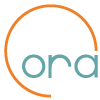Ora® Method
POSTURE CORRECTOR
Simple method and easy to use !
1 device – 3 exercises – 2 mn / day

3 SIMPLE EXERCISES TO PRACTISE ONE AFTER THE OTHER. FOR YOUR COMFORT, YOU CAN PUT A FLAT PILLOW UNDER YOUR NECK AND KNEES.
Starting position: Lying on your back with your legs outstretched, arms straight along the sides of your body, without overdoing it, slow movements, with the Ora® device in your mouth.
The ORA device is universal and can be adapted to all mouth sizes, in both children and adults.
Adjust the distance between the ORA bearings to your jaw and put them on your molars (back teeth), with the wings to the bottom. Gently clench. Do not masticate – it could lead to a premature wearing effect on the bearings. The ORA device, with its soft bearings, repositions all the joints from the Temporo-Mandibular Joint (TMJ).
Exercise 1

In the starting position raise your outstretched left arm vertically, against your left ear. If possible, your arm should go all to way to the ground. Immediately return your arm to the starting position.
Alternate left and right arms.
Répétez this exercise 3 times.
Exercise 2

In the starting position bend your knees to a 90° angle, with your feet flat on the floor. Imitate pedalling movements by stretching your right then left leg up.
Your back should remain flat on the floor.
Repeat this exercise 5 times.
Exercise 3

In the starting position raise your right arm. If possible, your arm should go all to way to the ground (as in exercise 1). Bend your left knee and bring it as close as possible to your chest. Then relax your arm and leg back to the starting position.
Alternate right leg/left arm and left leg/right arm.
Repeat this exercise 3 times.
CAUTION : AT THE END OF THE EXERCISES, REMOVE THE DEVICE, TURN OVER ONTO YOUR SIDE TO SIT UP, THEN STAND UP SLOWLY.
Ora® is an intra oral device intended to reposition the Temporo-Mandibular Joints (TMJ), thereby restoring postural balance.
An imbalance of the maxillary axis forces the spinal column to compensate on 3 levels: sagittal, frontal and horizontal (flexion, extension, lateral flexion and rotation).
Frequent symptoms :
- Noisy or cracking TMJs.
- Deviation of the mandible when lowering the jaw, or reduced mouth opening capacity.
- Earache.
- Headache behind the ear, temple and back of the head.
- Teeth grinding (bruxism), speech and eye muscle problems.
- Snoring.
Rare symptoms :
- Temporary or permanent loss of hearing.
- Dryness of the mouth and reduction of saliva.
- Loss of taste.
Rebalancing the joints means removing the mechanical causes that disrupt the neurovegatitive system.
The physiological repositioning of the TMJ achieved by using ORA prevents incorrect tooth positioning and its consequences in children: snoring, open mouth, teeth grinding.
The Temporo-Mandibular Joints (TMJ) (jaw joints) are part of the locomotive system.
The ORA device is used in association with a physiotherapy method of self-correction and active, self-induced movements of the joints.
A functional change caused by a malocclusion of a few microns can lead to a gap between the TMJ and have multiple repercussions.
Symptoms which may occur in the locomotive system :
- Cracking joints.
- Muscular tension.
- A change in the range of hypo- and hypermobility.
- A change in the relative length of limbs (upper/lower).



